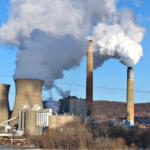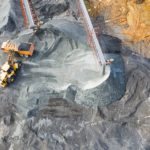This is the fifth blog in our Examining Climate series, where CCJ staff members and others will be sharing their favorite (or least favorite) climate solution, looking at the benefits and the costs in the hope of sparking an honest conversation about how we address the climate crisis and keep our focus on environmental justice. This blog was written by CCJ Senior Organizer Nick Hood.
Cryptocurrency is just about everywhere these days. The two most well-known and currently used are Bitcoin and Ethereum, but there are numerous others out there as well. Crypto commercials featuring celebrities have flooded television and internet ads; athletes are including a portion of crypto when signing new salary contracts; banks are offering crypto investment opportunities to their customers; and recently, crypto has become more and more a topic discussed by our federal government.
Let us backtrack for a moment. First, cryptocurrency 101. Wikipedia (all hail) defines cryptocurrency as:
A cryptocurrency or crypto is a digital currency designed to work as a medium of exchange through a computer network that is not reliant on any central authority, such as a government or bank, to uphold or maintain it. Individual coin ownership records are stored in a digital ledger, which is a computerized database using strong cryptography to secure transaction records, to control the creation of additional coins, and to verify the transfer of coin ownership.
It’s digital money with a digital ledger to create coins and track transactions. To get a coin, you must solve a complex algorithm. An algorithm is a procedure or formula for solving a problem. A complex algorithm is an algorithm that embodies advanced mathematical or logical methods and requires at least one thousand (1000) lines of the C/C++ programming language to implement.
It is not easy to solve the algorithm and definitely not something you can do with just a simple calculator: Solving it will require a computer. The amount of processing power that your computer has will determine how efficiently and timely you will be able to provide the correct answer to the algorithm and thus, receive a piece of the cryptocurrency. People or companies can build powerful computers with very high processing power for the sole purpose of solving these crypto algorithms; this is commonly referred to as data mining.
There are two main ways to mine for crypto. One is called Proof Of Work and the other is called Proof of Stake. Bitcoin and Ethereum both utilize Proof of Work, but there are plenty of others that use Proof of Stake. Both have their pros and cons associated with them. Proof of Stake requires participants to put down cryptocurrency as collateral for the opportunity to successfully approve transactions, i.e.,the more you buy in, the more you get a chance to solve the algorithm. Proof of Work is more secure than Proof of Stake, but it’s slower and consumes more energy. Proof of Work systems allow every participant the chance to solve the algorithm every time a new coin is minted, but only certain “winners” are chosen from those who have successfully solved the algorithm. With Proof of Stake, only certain participants are given the chance to mine the algorithm.
If that seems too complex, it’s because it is. For our purpose, the main thing to note is that Proof of Work uses and wastes much more energy.
Major news outlets have recently highlighted this excessive use of energy. Studies have shown that more energy was spent last year on mining Bitcoin than what some entire countries used in that same year. And mind you, Bitcoin is just one of many types of crypto.
An ordinary person can mine for crypto, as long as they have a pretty powerful computer setup to solve an algorithm, which can be bought online for anywhere from a few hundred dollars to thousands and thousands of dollars. The processors used to help power the computer need energy, and the more processors you have, the more energy you use – but the more efficiently you can solve algorithms.
What does coal have to do with this?
Big business also has its eye on crypto, and it has certainly been dabbling into crypto in a very auspicious way. There are companies coming into PA and into old coal towns claiming to clean up coal waste sites that were abandoned before the 1970s. Since the mid-1970s, the law has required coal extraction companies to properly dispose of and control their coal waste, but pre-1970s mine waste sites pockmark our region and can have a negative impact on wildlife and our water sources.
Old power plants that were once used to burn coal for power generation are now being used to burn coal waste to help power cryptocurrency mining computers and processors. Stronghold Digital Mining is one such company already operating north of Pittsburgh and in another area in the eastern part of the state. Coarse coal waste is a mixture of coal ash, coal dust, sediment, heavy metals, limestone, and sandstone; it doesn’t rank high on the clean fuels list. Stronghold claims that “This once-unusable waste material was left in expansive piles throughout the area because the technology did not exist to efficiently burn it. Today, circulating fluidized bed technology allows for the efficient and emissions-controlled conversion of coal refuse into energy.”
This isn’t eliminating pollution, it is only moving it, and to what end? To waste a bunch of energy and get rich while doing very little for the community? To provide temporary and dangerous jobs that expose workers and the community to harmful air pollution?
Luckily, there are some real solutions to fix these legacy coal waste piles. The federal government recently approved 11 billion dollars through the Bipartisan Infrastructure Bill that is specifically earmarked to help mitigate these pre-1970s abandoned mine lands.
We could use this money to pay people in our communities to actually help mitigate these coal waste piles that have been left unattended near people’s homes for decades. That would be a better option both economically and environmentally – much better than a few rich people creating toxic pollution to power computers so they can get even richer. The craziest thing to me is that this kind of nonsense is paid for with tax deductions and by using tax incentives because they claim to “clean up the waste.”
You can’t even make this stuff up: Rich people get paid to clean up pollution, by creating pollution in order to get richer.
Instead it should be: Communities that have been extracted from for generations and have been left with unattended coal waste and economic hardship are paid to clean up and restore their coal country’s lands back to their original beauty. Doesn’t it make more sense to address some of the harms that have been done??
Talk to your township supervisors, county commissioners, and legislators and let them know we don’t want to waste our opportunity to actually clean up this legacy pollution. Let’s try to figure out some real solutions that could be good for us all and not just a few. We need shovel-ready projects that can sustain us long-term and are worthy of some of that $11 billion.
With all this said, I think cryptocurrency can and should exist at some level and I don’t advocate for everyone to sell all their crypto shares, coins, and everything that is digital currency. Cryptocurrency, at it’s very idealized core, could be a good thing: These digital currencies are decentralized, and they operate in a very secure way with minimal human interactions that could help to erase discrimination in our financial systems. Currently, however, our financial systems set aside some projects and opportunities for select groups of people which are not available to others. These groups get some favors like soft loans, prolonged payment durations, and lower interest rates. As a result, the current system can end up being unfair and devoid of financial inclusion. These wrongs should be addressed.
I think that if done responsibly, cryptocurrency and cleaning up coal waste sites could be done right. Let’s educate ourselves and others and advocate for more responsible energy and coal waste mitigation practices.



